- Naming of Cho Oyu Mounatin
- The exact Location and Elevation of Mount Cho Oyu
- Geographical Location of Mount Cho Oyu:
- The Height of Mount Cho Oyu
- History of Climbing Mount Cho Oyu
- Mount Cho Oyu Expeditions: Modern Climbing Context
- Permits and Costs for Climbing Mount Cho Oyu
- Climbing Routes on Mount Cho Oyu
- Weather and Optimal Climbing Times for Mount Cho Oyu
- Trekking Opportunities
- Cultural and Scenic Highlights
- Environmental Conservation Initiatives
Mount Cho Oyu, which rises to an elevation of 8,188 meters (26,864 feet), is the sixth-highest mountain in the world. The majestic peak is situated on the border that separates Nepal from the Tibet Autonomous Region of China, approximately 20 kilometers west of the iconic Mount Everest. The Tibetan name Cho Oyu, meaning Turquoise Goddess, encapsulates its rich color and cultural significance and explains its deep-rooted traditions and folklore.
The Austrian expedition completed the first successful summit on October 19, 1954, marking a new milestone in high-altitude climbing. Mountaineers from all over the globe prefer Cho Oyu because it is the easiest summit among the 8000-meter mountains.
The history of Mount Cho Oyu will be explored in this blog, along with its remarkable height, precise location, and distinctive features that contribute to its significance in the Himalayan landscape.
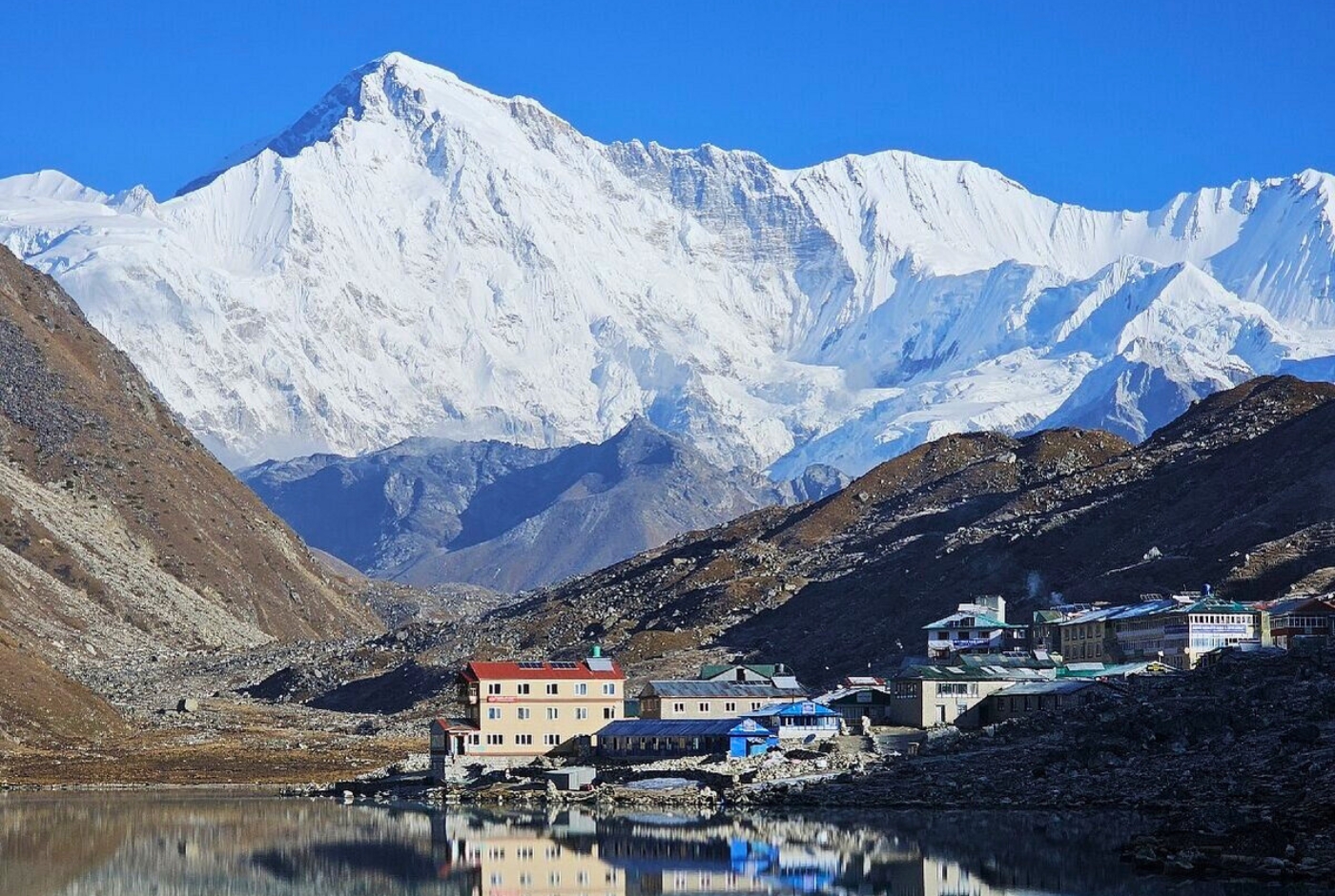
Naming of Cho Oyu Mounatin
"Cho Oyu" comes from Tibetan, meaning "Turquoise Goddess." Under specific lighting conditions, the mountain beautifully showcases a striking turquoise hue, which adds to its charm and mystery.
In Chinese, the mountain is called "卓奥友峰" (pinyin: Zhuó'àoyǒu Fēng), which is a phonetic representation of the Tibetan name rather than having a distinct meaning in Chinese. While maintaining its Tibetan character, this adaptation highlights the significance of this magnificent peak across many cultures.
In Nepali, Mount Cho Oyu is known as "चोयु" (Choyu), closely resembling its Tibetan counterpart. Strong cultural and linguistic ties between the Tibetan and Nepali communities. This majestic mountain is a powerful reminder of their shared experiences and values, weaving together the stories and traditions that thrive in this awe-inspiring landscape.
The mountain's name and variations in different languages highlight its cultural importance and illustrate the linguistic interactions between the regions it links.
The exact Location and Elevation of Mount Cho Oyu
Mount Cho Oyu soars to an impressive height of 8,188 meters (26,864 feet), making it the sixth-highest mountain in the world. It is precisely located at the coordinates of 28°05′39″N latitude and 86°39′39″E longitude. This remarkable peak lies in the Autonomous Region of China, approximately 20 kilometers (12 miles) west of Mount Everest.
Location of Mount Cho Oyu: Where is Mount Cho Oyu Located?
Nestled in the Mahalangur Himal region of the Himalayas, Mount Cho Oyu serves as an essential natural link between Tibet and Nepal, signifying the rich cultural legacy both countries have in common. This majestic mountain is 5716 meters (18753 feet) close to the Nangpa La Pass, a major glaciated trade route. In the past, Nangpa La has been essential in promoting trade and commerce between the Sherpa and Tibetan populations in the Khumbu region, enabling the sharing of customs, culture, and goods. The strategic location of Cho Oyu not only enhances its significance as a climbing destination but also highlights its importance as a cultural and economic bridge between these two unique and vibrant communities in the Himalayas.
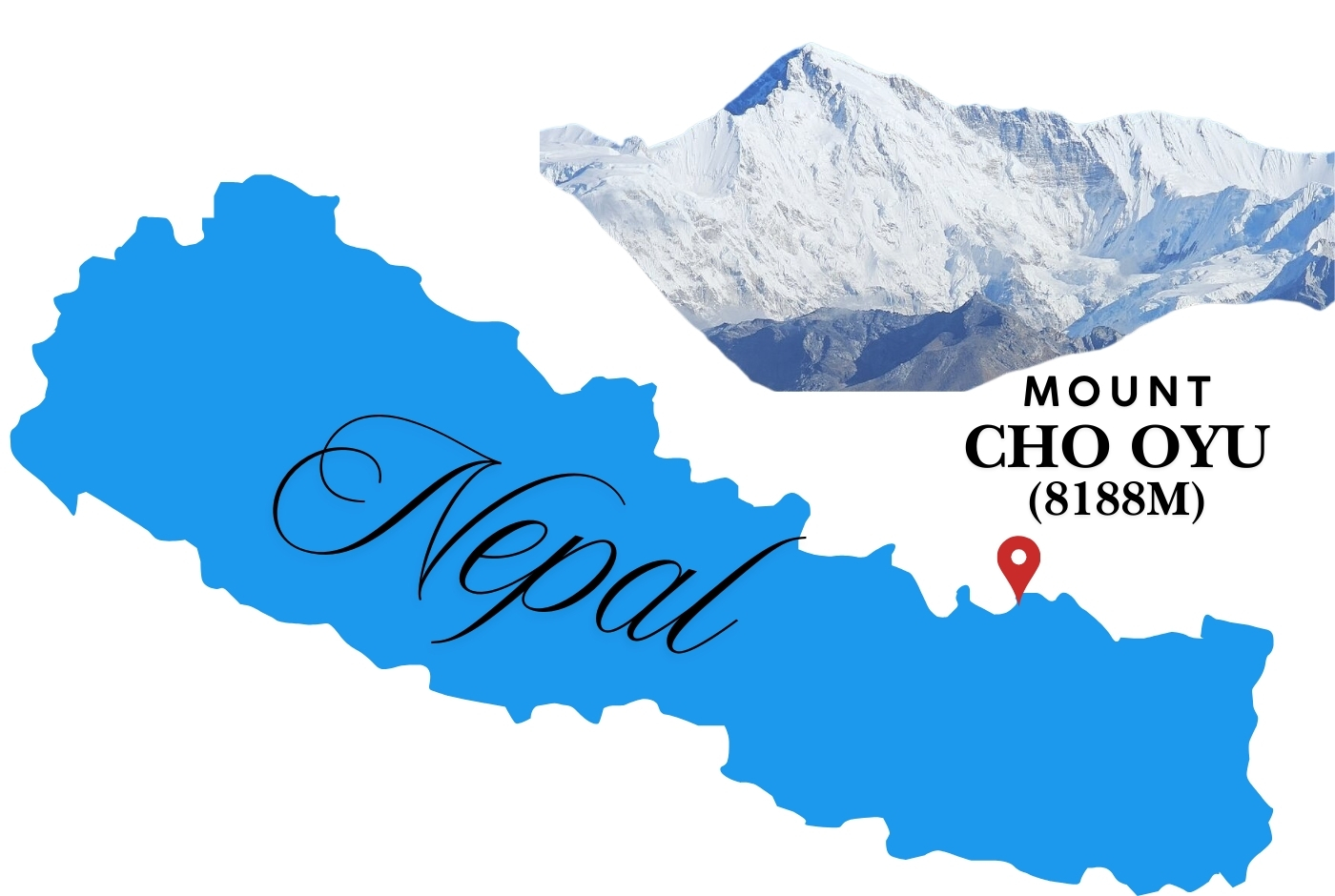
Significance of Mount Cho Oyu
Symbol of Achievement: A popular starting point for individuals attempting high-altitude climbing, Mount Cho Oyu is regarded by mountaineers as one of the more approachable peaks over 8000 meters. Because of its comparatively mild slopes, adventurers from around the world come here to take on its challenges and take in the Himalayas' breathtaking beauty.
Spiritual Reverence: "Cho Oyu," or "Turquoise Goddess" in Tibetan, reflects the mountain's significance in local culture.
Geographical Location of Mount Cho Oyu:
Mount Cho Oyu, located at 28°05′39" N and 86°39′39" E in the central Himalayas, acts as a cultural bridge between Nepalese and Tibetan traditions, highlighting their close ties across the Nepal-Tibet border.
Administrative Divisions:
● Mount Cho Oyu is found in Nepal in Province No. 1, in the Solukhumbu District. This area of the larger Sagarmatha Zone is well known for its ecosystem. It is geographically and ecologically significant because it contains several high-altitude terrains and prominent peaks.
● In Tibet (China): On the Tibetan side, Cho Oyu is in Tingri County, part of Shigatse Prefecture, is distinguished by its vast, high-altitude plateaus, and is home to various Tibetan communities with rich cultural traditions and practices.
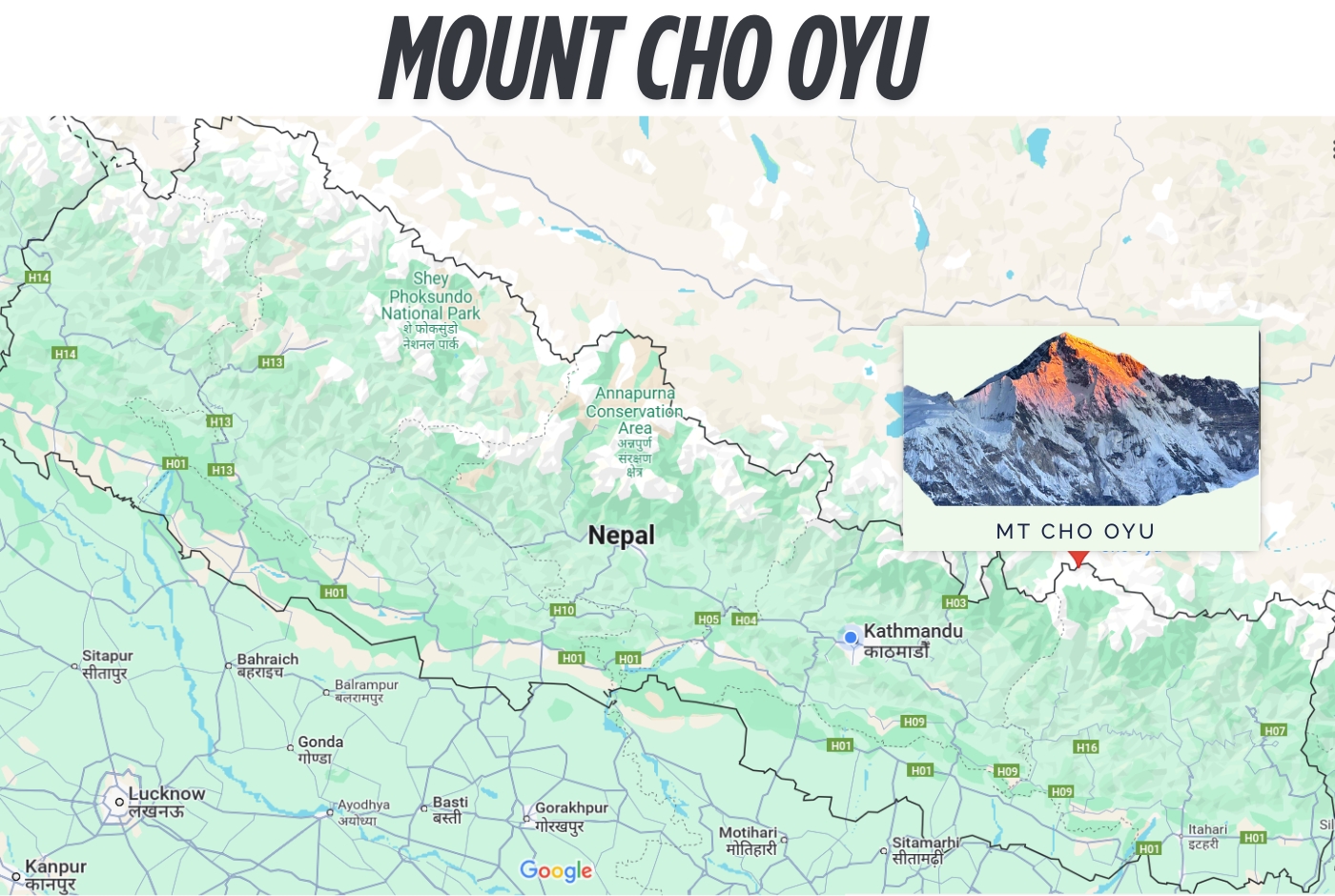
Himalayan Range:
Mount Cho Oyu sits in the stunning Himalayan range that nebulously reaches across five countries, including Nepal and China. This sprawling mountain range, while a wonder in its own right — full of breathtaking scenery — is a testament to the geological wonders.
Surrounding Mountains: Mount Cho Oyu is surrounded by several other prominent peaks that contribute to the dramatic skyline in this part of the world. These prominent peaks include Mount Everest, the highest mountain on Earth, with a height of 8,848.86 m; Lhotse, 8,516 m; and Makalu, 8,485 m.
Geological and Physical Features of Mount Cho Oyu
Mount Cho Oyu, the sixth-highest mountain in the world, is a prominent feature of the Himalayan landscape, with its impressive formation resulting from the ongoing tectonic collision between the Indian and Eurasian plates. This geological process began about 50 million years ago and continues to shape the region's dramatic topography.
Geological Composition
The geological makeup of Mount Cho Oyu provides significant insights into its complex formation history.
Metamorphic Rocks: The base of Cho Oyu consists mainly of metamorphic rocks, such as schists and gneisses, which have transformed due to intense heat and pressure, indicating significant geological activity during the mountain's development over millions of years.
Igneous Rocks: Above the metamorphic base, one can find layers of igneous rocks, predominantly granites, and these formations indicate a history of volcanic activity, which has shaped their current form.
Sedimentary Rocks: As climbers approach the summit, they find sedimentary layers of limestone and sandstone, remnants of a prehistoric ocean before the Himalayas rose.
Topography of Mount Cho Oyu
The physical landscape of Cho Oyu is defined by various features that both challenge and entice mountaineers seeking to conquer its heights:
Ridges:
Northwest Ridge: The Northwest Ridge is the most popular among climbers and is known for its relatively gentle slopes and easy accessibility.
Southeast Ridge: However, the Southeast Ridge is less commonly traversed and presents a significantly more technical challenge. This route demands a higher level of skill and experience.
Glaciers:
Nangpa Glacier: The Nangpa Glacier, situated west of Cho Oyu and descending from the mountain's northwest face, is an impressive geographical feature essential to the region's ecology. Adjacent to it is the historically significant Nangpa La Pass, which serves as a trade route at an elevation of 5,716 meters (18,753 feet).
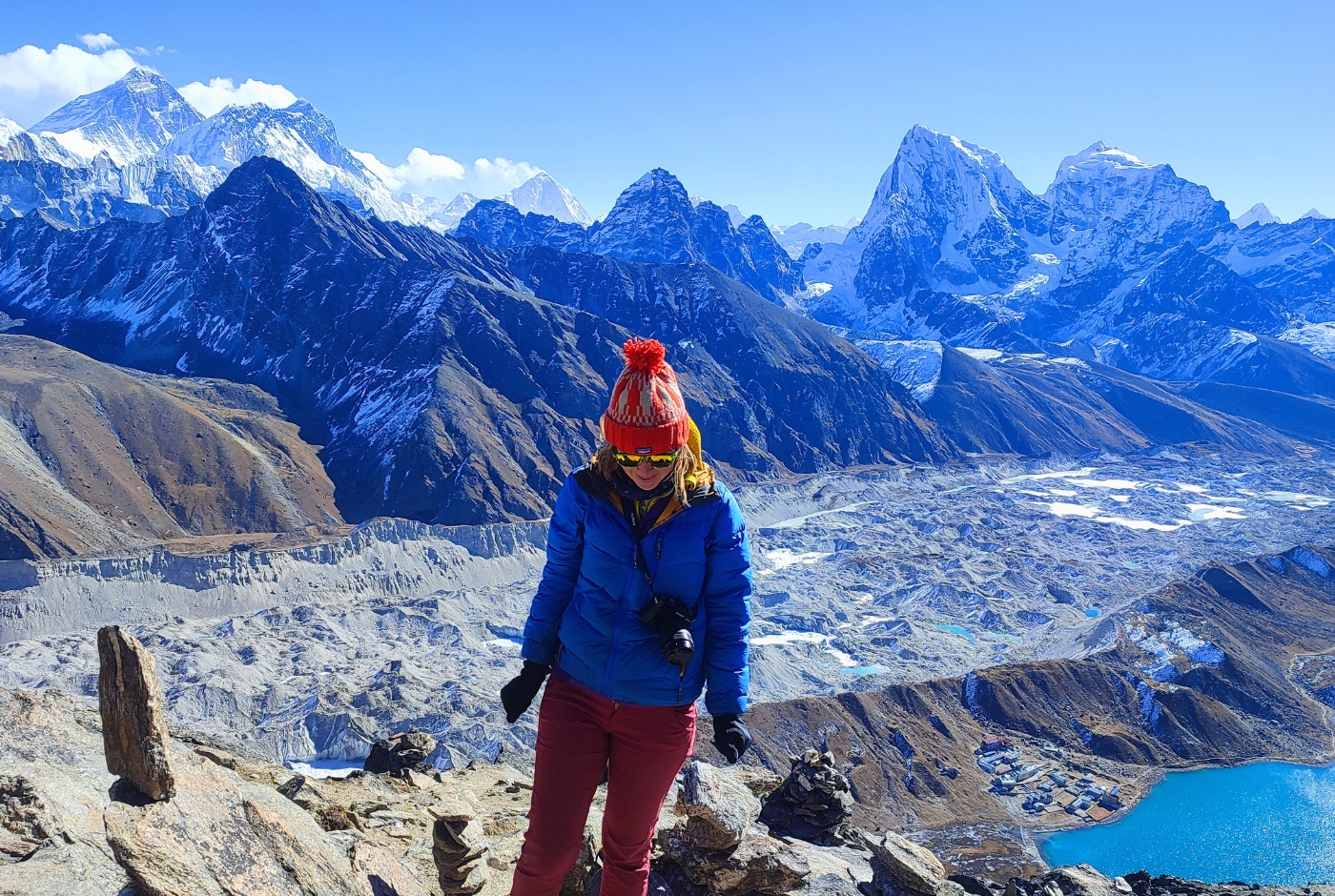
Icefalls:
Northwest Face Icefall: Climbers ascending the northwest ridge must navigate the Northwest Face Icefall, a challenging section characterized by crevasses and seracs that require careful route planning and advanced technical skills.
The geological and physical features are crucial for climbers aspiring to summit Cho Oyu, as they offer vital information to the climbers for a fully equipped summit.
The Height of Mount Cho Oyu
Mount Cho Oyu, recognized as the fifth-highest mountain in Nepal and the sixth-tallest worldwide, has led to differing recorded elevations over the years, standing at 8,188 metres (26,864 ft) above sea level.
Early Measurements: Initially measured at 8,150 meters (26,750 feet), Cho Oyu was recognized as the seventh-highest peak in the world, but a revised assessment in 1984 adjusted its elevation to 8,201 meters (26,906 feet), correcting previous figures and elevating its rank to the sixth-highest mountain globally.
1996 Survey: The widely recognized measurement of Mount Cho Oyu's height was determined during an extensive survey carried out in 1996.
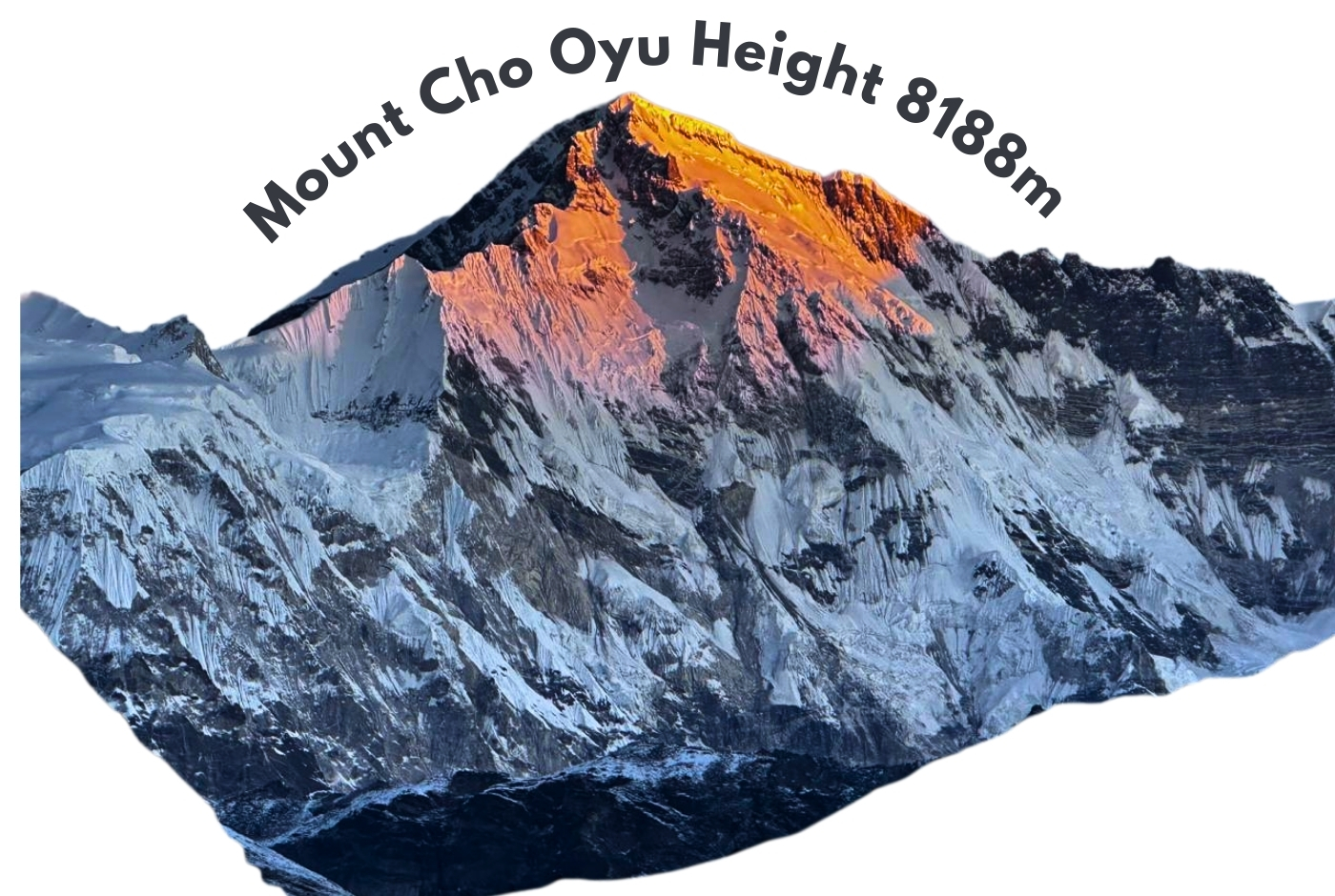
Measurement Challenges
Mount Cho Oyu presents several significant challenges:
Remote Location: The Mountain’s strategic location in the Autonomous Region of China presents access challenges that restrict opportunities for on-site surveys.
Technological Limitations: The initial measurements of Cho Oyu's height utilized outdated technology, leading to discrepancies in the reported elevations; in contrast, the 1996 survey used more advanced instruments and methods essential for determining the mountain's accurate height.
Geological Activity: The Himalayan region is marked by persistent tectonic activity resulting from the collision of the Indian and Eurasian plates. Such dynamic geological processes complicate height measurements, as the mountain's altitude may vary slightly due to the natural forces at work.
History of Climbing Mount Cho Oyu
Early Attempts and First Ascent
1952 Expedition: The first recorded attempt to summit Cho Oyu took place in 1952, led by a British expedition under Eric Shipton, which included notable climbers such as Edmund Hillary, Tom Bourdillon, and George Lowe, who encountered significant technical challenges, including an ice cliff at 6,650 meters (21,820 feet) that posed avalanche risks, and concerns about nearby Chinese military activities ultimately led them to retreat without reaching the summit.
1954 First Ascent: On October 19, 1954, an Austrian expedition led by Herbert Tichy, Joseph Jöchler, and Sherpa Pasang Dawa Lama achieved the first ascent of Cho Oyu via the northwest ridge, remarkably completing the climb without supplemental oxygen despite the high-altitude challenges of the time.
Subsequent Developments
1958 Second Ascent: In 1958, an Indian expedition completed the second successful ascent of Mount Cho Oyu, with Sherpa Pasang Dawa Lama reaching the summit for the second time, but the climb also marked the mountain's first fatality, underscoring the dangers of high-altitude mountaineering.
1978 Southeast Face Ascent: In 1978, Austrian climbers Edi Koblmüller and Alois Furtner made their mark in climbing history by establishing a new route on the challenging southeast face of Cho Oyu, showcasing the evolving techniques and determination of climbers exploring the mountain's new facets.
1984 First Female Ascent: The year 1984 witnessed a historic achievement when Věra Komárková from the USA and Dina Štěrbová from Czechoslovakia became the first woman to summit Cho Oyu successfully. Štěrbová's accomplishment was particularly notable as it marked her as the first Czechoslovakian woman to ascend an 8,000-meter peak, breaking barriers and inspiring future generations of female climbers.
1985 First Winter Ascent: On February 12, 1985, Polish climbers Maciej Berbeka and Maciej Pawlikowski reached a new milestone by achieving the first winter ascent of Cho Oyu.
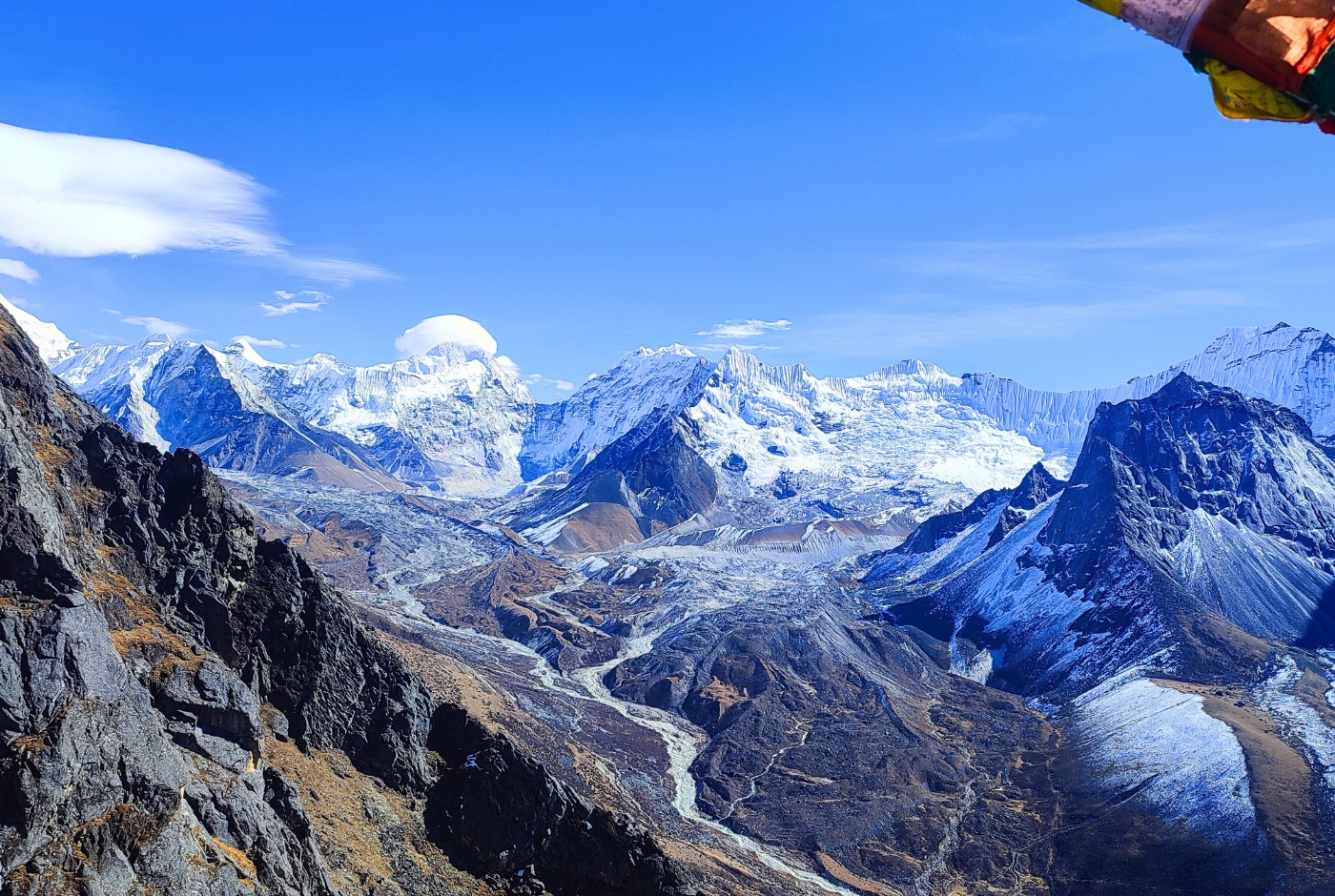
Mount Cho Oyu Expeditions: Modern Climbing Context
Mount Cho Oyu is often considered one of the more accessible 8,000-meter peaks due to its relatively lower death-to-summit ratio and moderate technical requirements along the standard northwest ridge, attracting aspiring mountaineers, with over 3,000 climbers successfully reaching the summit, reflecting advancements in climbing technology and gear.
The mountain's location near the Nangpa La Pass, an important historical trade route between Tibet and Nepal, adds cultural significance to its climbing history and has long facilitated trade and cultural exchange between the two regions. While Cho Oyu is considered a more accessible 8,000-meter peak, climbers must still be vigilant and well-prepared for the challenges of high-altitude mountaineering. These challenges include rapidly changing weather conditions and potential altitude-related health issues like acute mountain sickness (AMS).
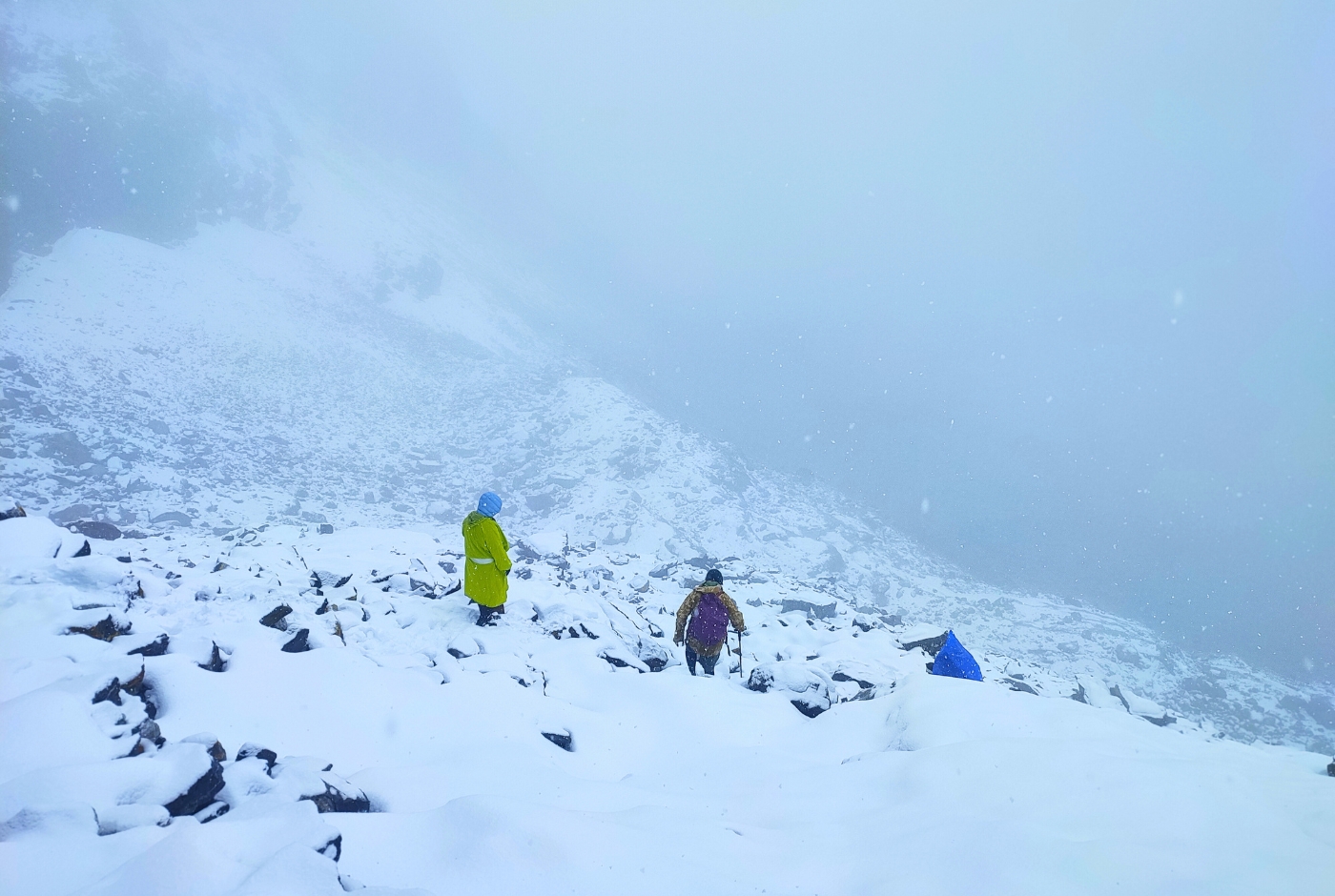
The Difficulty of Climbing Mount Cho Oyu
Climbing Mount Cho Oyu, the sixth-highest peak in the world at 8,188 meters (26,864 feet), is often viewed as more achievable than other 8,000-meter mountains. The standard northwest ridge route features moderate slopes and requires minimal technical skills, making it a popular option for mountaineers aiming for their first summit above 8,000 meters. However, the ascent still demands excellent physical fitness and proper acclimatization due to the extreme altitude. Climbers encounter challenges like a 150-foot ice cliff and the Yellow Band at around 7,500 meters (24,600 feet), which can be exhausting at high elevations, even though they aren't technically challenging. The mountain's high-altitude places climbers in the "death zone," where low oxygen levels increase the risk of altitude-related illnesses; thus, despite being a less technical climb, Cho Oyu remains a significant high-altitude challenge that demands thorough preparation and awareness of the associated dangers.
Climbers encounter specific obstacles, including a 150-foot ice cliff and the Yellow Band, located at around 7,500 meters (24,600 feet). While these sections are not technically challenging, they can tax climbers at high elevations with thin air.
Additionally, the high elevation of Cho Oyu places climbers in what is known as the "death zone," where oxygen levels are critically low. This condition significantly heightens the risk of altitude-related illnesses, such as acute mountain sickness (AMS), high-altitude pulmonary edema (HAPE), and high-altitude cerebral edema (HACE). Proper acclimatization strategies and understanding the risks are crucial for ensuring a safe and successful ascent.
Mortality Rates on Mount Cho Oyu: Mount Cho Oyu, which rises to an elevation of 8,188 meters (26,864 feet), is regarded as one of the more accessible peaks among the 8,000-meter mountains, boasting relatively lower mortality rates than other giants in this category.
Multiple Ascent Routes: While the northwest ridge is the most commonly utilized route for summiting Cho Oyu, the mountain boasts 13 established climbing routes. This variety allows climbers to choose paths that match their skill levels and preferences.
First Winter Ascent: On February 12, 1985, Polish climbers Maciej Berbeka and Maciej Pawlikowski achieved a significant milestone in Cho Oyu's climbing history by completing the first winter ascent via a new route on the southeast face.
Flat Summit Plateau: The summit of Cho Oyu features a flat plateau, making it difficult for climbers to identify the highest point.
Disputed Ascents: The flat summit plateau has led to disputes over summit claims, such as British climber Alan Hinkes' 1990 assertion, which was challenged due to poor visibility that may have affected his confirmation.
Historical Expedition: In 1952, a British expedition led by Eric Shipton, which included well-known climber Edmund Hillary, attempted to ascend Cho Oyu as part of their preparation for an Everest expedition. Unfortunately, they were forced to retreat due to technical difficulties and concerns over Chinese military activity in the vicinity.
First Ascent Without Supplemental Oxygen: The first successful summit of Cho Oyu took place in 1954, accomplished by climbers Herbert Tichy, Joseph Jöchler, and Sherpa Pasang Dawa Lama. Remarkably, they accomplished this feat without supplemental oxygen, a significant achievement for that era.
Proximity to Nangpa La Pass: Mount Cho Oyu is located near the Nangpa La Pass, a glaciated trade route that has historically been a crucial link between Tibet and the Khumbu region of Nepal.
Name Meaning: "Cho Oyu" translates to "Turquoise Goddess" in Tibetan, a title that reflects the mountain's stunning appearance.
Climbing Popularity: By December 2022, Cho Oyu had seen 3,923 successful summits, establishing it as one of the most popular peaks among the mountains, exceeding 8,000 meters in height.
First Female Ascent: In 1984, Věra Komárková from the USA and Dina Štěrbová from Czechoslovakia made history by becoming the first women to successfully summit Cho Oyu, breaking barriers and inspiring future generations of female climbers.
Permits and Costs for Climbing Mount Cho Oyu
Mount Cho Oyu lies on the border between Nepal and the Tibet Autonomous Region of China and presents climbers with two primary routes of approach, each accompanied by specific permit requirements and associated fees.
Nepal Approach: Obtaining climbing permits from the Government of Nepal's Department of Tourism is mandatory for those launching their expeditions from Nepal. The permit fees for Cho Oyu are standardized across all peaks that exceed 8,000 meters and are structured by season as follows:
- Spring Season (March to May): USD 1,800 per person
- Autumn Season (September to November): USD 900 per person
- Winter/Summer Seasons (December to February and June to August): USD 450 per person
These fees are subject to change, so climbers should check with the official Nepalese Department of Tourism or reputable expedition operators for the most up-to-date information.
Tibet (China) Approach: Climbing from the Tibetan side necessitates permits from Chinese authorities, with fees typically higher than those for Nepalese. According to recent data, the climbing permit fee from the Chinese government is about USD 9,300 per person, along with an additional fee of around USD 4,000 per person for guides. These costs can change, so verifying the most current rates through official sources or knowledgeable expedition organizers is essential.
Permit fees differ from other expedition costs like logistics, guiding, equipment rental, and support. Expedition packages can vary widely, with all-inclusive services for climbing Cho Oyu costing between USD 13,000 and USD 35,000 per person.
Climbing Routes on Mount Cho Oyu
Mount Cho Oyu features several established routes for climbers, with the most notable being:
Northwest Ridge (Tibet Side): The most frequently used route, the Northwest Ridge, is regarded as the standard ascending pathway. Approaching from the Tibetan side, the Northwest Ridge is well-known for its moderate slopes and is considered less technically challenging than other peaks exceeding 8,000 meters.
Southwest Face (Nepal Side): The Southwest Face is less commonly attempted and offers more considerable technical challenges for climbers, mainly due to the heightened technical difficulty and the logistical complexities of organizing such climbs.
Choosing the correct route is essential as it affects the required technical skills, necessary preparation, and overall expedition costs. Collaborating with reputable expedition operators can help navigate the permit process, arrange logistics, and ensure a safer, more informed climbing experience.
Overall Mortality Rate
As of December 2024, there have been 4,027 successful summits of Cho Oyu, alongside 52 recorded fatalities, resulting in an overall mortality rate of approximately 1.3%.
Mortality Rate During Descent
Research on climber safety highlights the dangers of descending from high-altitude summits. Cho Oyu has an estimated mortality rate of around 0.4% during descent, suggesting that while it is generally safer than other 8,000-meter peaks, careful attention and planning are still essential for a safe descent.
Comparison with Other Eight-Thousanders
Compared to other peaks over 8,000 meters, Mount Cho Oyu has significantly lower mortality rates, with Annapurna I at approximately 31.9% and K2 at around 14.1%, a difference often attributed to Cho Oyu's less technical standard routes and the relatively stable weather conditions that make the ascent more manageable for climbers.
Factors Contributing to Mortality
The primary causes of fatalities on Cho Oyu stem from several factors, including falls, altitude-related illnesses such as acute mountain sickness (AMS), high-altitude cerebral edema (HACE), and high-altitude pulmonary edema (HAPE). Severe weather conditions can also play a critical role in climbers' safety. Despite Cho Oyu's reputation as a more accessible eight-thousander, climbers must remain vigilant and not underestimate the inherent risks of high-altitude mountaineering.
Weather and Optimal Climbing Times for Mount Cho Oyu
The extreme weather conditions on Mount Cho Oyu require careful planning, as the mountain's high-altitude climate greatly influences climbing feasibility, safety, and summit success rates.
From March to May, climbers often experience more stable weather during the pre-monsoon spring, making it an ideal time for ascent. In contrast, the monsoon season from June to August brings heavy snowfall and unstable conditions. Winter also poses challenges with extreme cold and harsh winds, reducing the likelihood of a successful climb. Thus, understanding weather patterns and choosing the best season is crucial for safety and improving summit success on this majestic peak.
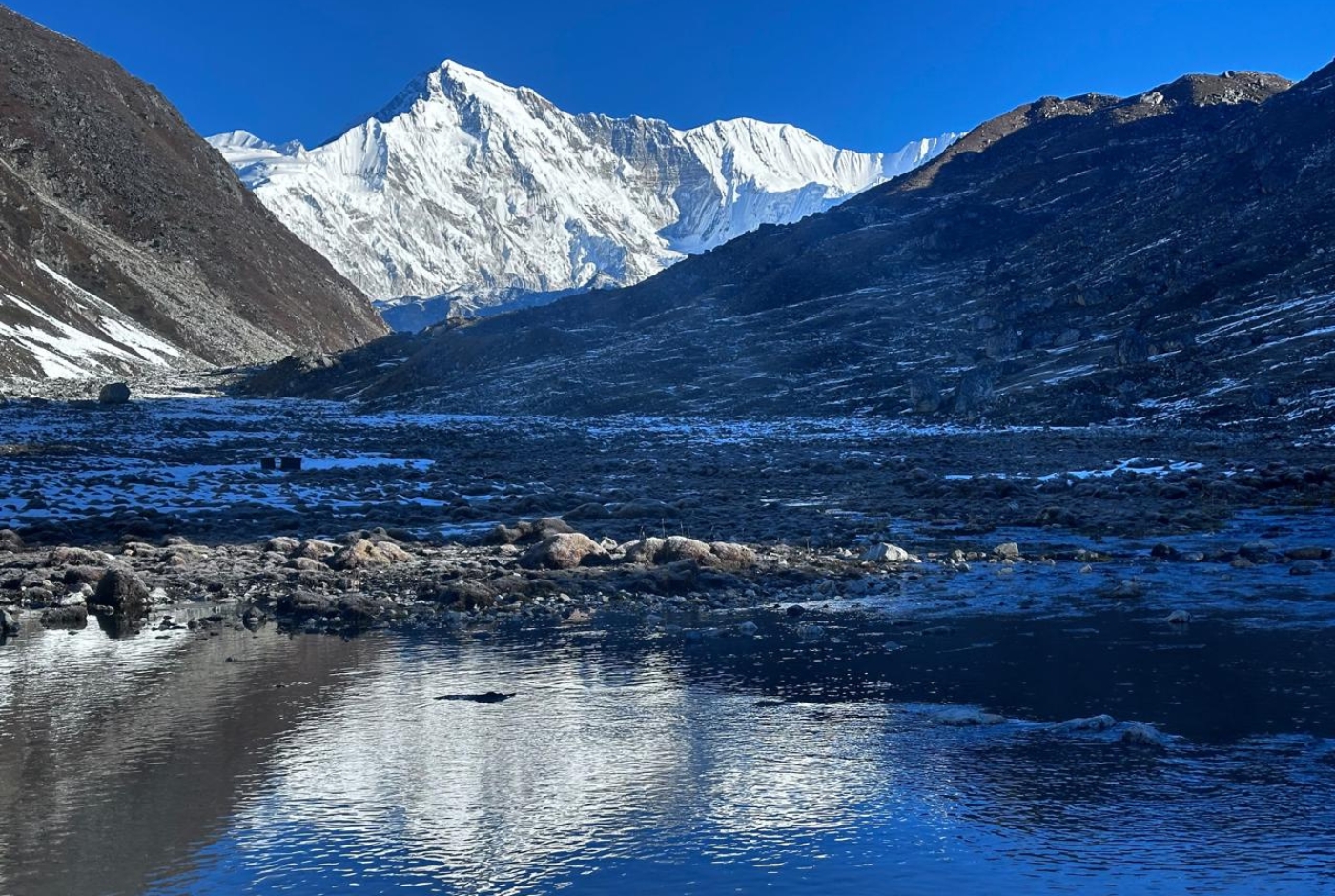
Weather Conditions on Mount Cho Oyu
Mount Cho Oyu's weather is mainly influenced by the South Asian monsoon and the winter jet stream, which determine the climbing seasons. From June to August, the monsoon season is characterized by heavy snowfall and erratic weather patterns, making climbing expeditions unfeasible. From December to February, climbers encounter extreme cold, hurricane-force winds, and heavy snow accumulation, all contributing to the infrequency of successful ascents.
In the pre-monsoon spring season (April to May) and the post-monsoon autumn season (September to October), the weather is considerably stable, featuring lower wind speeds and more moderate temperatures than harsh winter conditions. However, even in these more favorable seasons, summit temperatures can plummet to between -30°C and -40°C (-22°F to -40°F), necessitating proper acclimatization and the use of high-altitude gear for climbers to cope with the extreme environment.
Best Time to Climb Mount Cho Oyu
Spring Season (April to May): This period is considered one of the best times for ascending Cho Oyu. The weather is generally more stable, and temperatures are a bit warmer than those experienced in autumn. Additionally, snow conditions during spring are more favorable for climbing, offering better traction and stability on the mountain.
Autumn Season (September to October): The post-monsoon season presents an optimal climbing opportunity. The sky is usually clear around this time, and avalanche risk is lower than in spring. Climbers should be aware, however, that temperatures start to fall later as winter approaches, leading to slightly cooler conditions than in the spring months.
An extensive understanding of these weather patterns and choosing an appropriate climbing season will maximize safety and success on Mount Cho Oyu.
There are so many benefits that AI tools provide that are worth noting. You have a knowledge base until October 2023. The optimal times for climbing Mount Cho Oyu are during the spring months of April and May, as well as in the autumn months of September and October, when the weather is typically more stable.
While Cho Oyu is often perceived as one of the more accessible 8,000-meter peaks, the climb still requires careful consideration to mitigate risks and enhance the likelihood of a successful expedition. Preparing properly — physically and through acclimatization — is crucial for facing high-altitude climbing challenges.
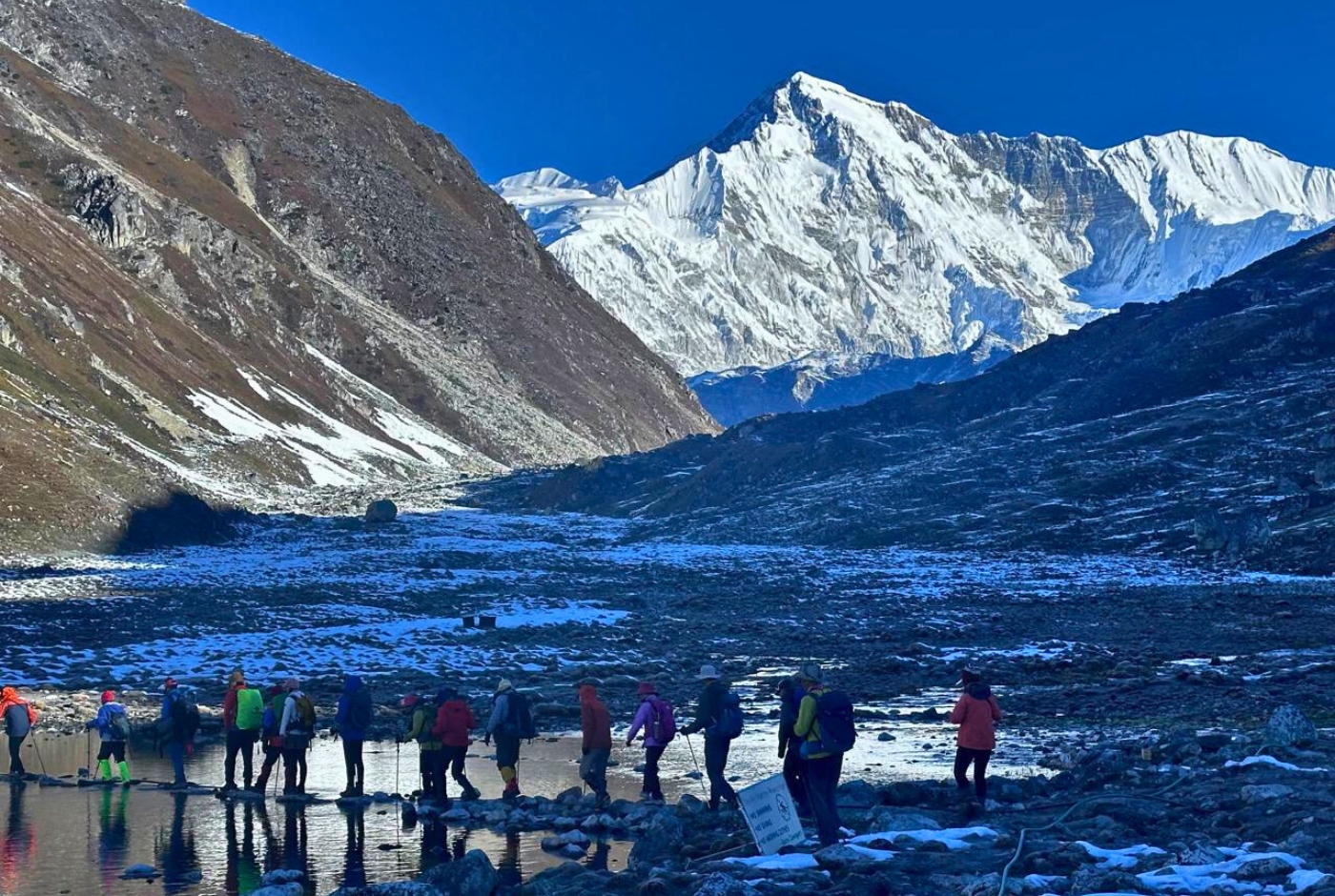
Climbing Mount Cho Oyu: The Challenges
Climbing Mount Cho Oyu is a highly technical experience that requires extensive planning, given the many challenges to overcome. Although it is considered one of the least challenging of the 8,000-meter Mountains, the gate to a safe and successful expedition is only a matter of serious planning.
Altitude and Acclimatization: Prolonged exposure to high altitudes necessitates a well-planned acclimatization strategy to reduce the risks associated with Acute Mountain Sickness (AMS). For their bodies to properly adjust to the thin air and lower oxygen levels, climbers usually set up several camps at steadily higher elevations. Interestingly, mountaineer Alan Arnette stresses that altitude is a significant barrier when attempting 8000-meter climbs and emphasizes the value of extra oxygen during summit attempts. Ensuring climbers can perform safely and effectively during their ascent and reducing the possible adverse effects of altitude requires proper acclimatization.
Technical Terrain: Climbers must traverse steep sections when ascending the Northwest Ridge, including a 50-meter ice wall of about 6800 meters. Climbers must be adept at using technical gear like ice axes and crampons for this section. The technical aspects of this route are regarded as moderate, even though climbing at high altitudes poses significant challenges with short ice and rock scrambling sections. The route offers a diverse climbing experience that requires skill and flexibility with snow slopes.
Weather Conditions: Because of the unpredictable weather, climbers may experience severe winds, sudden temperature drops, and much snow at higher elevations. Climbers also experience severe physical difficulties, such as losing sensation in their extremities due to the harsh wind and extreme cold.
Physical and Mental Endurance: The high-altitude climb, challenging terrain, and requirement to carry heavy loads make this expedition extremely physically and mentally demanding, with years of rigorous training and preparation enabling climbers to reach an 8000-meter peak.
Logistical Considerations: Getting the necessary permits, planning transportation to the base camp, and overseeing the support staff are just a few of the logistical difficulties of preparing for a climb of Mount Cho Oyu. Supplies and equipment must be handled carefully for an ascent to be successful. Since they offer crucial advice and assistance during the ascent, the experience of seasoned Sherpas who have guided climbers on Mount Everest can significantly increase their chances of success. Climbers confronted with the difficulties of high altitude can substantially benefit from their knowledge of the terrain and weather.
Health Risks: Cho Oyu poses significant health risks, which include frostbite, hypothermia, and illnesses related to high altitude. The primary altitude-related diseases to be aware of include acute mountain sickness (AMS), high-altitude pulmonary edema (HAPE), and high-altitude cerebral edema (HACE), all of which pose significant threats to climbers at extreme elevations.
Regulatory and Access Challenges: Political and environmental factors significantly influence access to Mount Cho Oyu and may lead to climbing restrictions. A challenging aspect of planning this expedition in this region has been the uncertainty surrounding the timely acquisition of permits from the China Tibet Mountaineering Association, especially for climbers looking to tackle the 14th and final peak, Shishapangma.
Climbing Expeditions: For climbers aiming to summit an 8,000-meter peak, Cho Oyu is often regarded as one of the more accessible choices by many climbers. The standard route along the Northwest Ridge has relatively moderate technical challenges, making it an attractive option. Most climbing expeditions set up several camps along the route, with the advanced base camp usually positioned at around 5,650 meters (18,530 feet). This ascent offers climbers breathtaking panoramic views of nearby peaks, including the famous Everest, Lhotse, and Makalu.
Trekking Opportunities
For those who are not interested in undertaking a whole summit expedition, the area surrounding Mount Cho Oyu offers a wealth of exceptional trekking experiences:
Gokyo Lakes and Gokyo Ri Trek: This trek, located in Nepal's Sagarmatha National Park, guides adventurers through the stunning Gokyo Valley, which is famous for its pristine turquoise lakes and the expansive Ngozumpa Glacier, the largest glacier in Nepal. Trekkers can ascend Gokyo Ri, a popular viewpoint perched at 5,357 meters (17,575 feet), where they can soak in breathtaking panoramic views of Cho Oyu, Everest, Lhotse, and Makalu.
Everest Base Camp Trek: One of the legendary treks in the world takes adventurers to the foot of Mount Everest's tallest peak, providing close-up views of this magnificent mountain and its surrounding summits. The path meanders through lively Sherpa villages, colorful rhododendron forests, and demanding high-altitude landscapes, reaching Everest Base Camp at 5,364 meters (17,598 feet). This trek offers views of the high peaks of the Himalayas. It engages trekkers deeply into the core of the Khumbu region, where they can encounter the area's local culture and stunning beauty.
Both treks offer once-in-a-lifetime experiences with their captivating landscapes and rich culture, so they remain the most sought-after by trekkers in the region.
Cultural and Scenic Highlights
These treks offer participants immersive experiences that delve into the rich local cultures and breathtaking natural beauty of the region:
Cultural Exploration: Travelers can explore local history in vibrant cities like Kathmandu and Nepal, often kick-starting their next adventure. They can visit ancient monasteries, impressive palaces, and lively weekly markets. With so much cultural exposure, trekking becomes a transformation journey for the trekkers.
Scenic Diversity: The journey is not only about a thrill, but it also soothes your journey with a variety of landscapes, including lush valleys, dense forests, and arid high-altitude deserts, providing both breathtaking scenery and physical challenges.
Flora and Fauna
Flora:
At lower elevations around Mount Cho Oyu, the landscape is predominantly characterized by forests filled with species such as pine (Pinus spp.) and hemlock (Tsuga spp.). As climbers end to higher altitudes, these forests transition into fir (Abies spp.), juniper (Juniperus spp.), birch (Betula spp.), and rhododendron (Rhododendron spp.) scrub. In the alpine ones, the plant communities consist of resilient species like mosses and lichens that thrive up to the snowline.

Fauna:
The wildlife surrounding Mount Cho Oyu is representative of the high-altitude Himalayan region.
Mammals: Notable species include the elusive red panda (Ailurus fulgens), the majestic snow leopard (Panthera uncia), the musk deer (Moschus chrysogaster), the Himalayan tahr (Hemitragus jemlahicus), and the Himalayan marmot (Marmota himalayana). These mammals have evolved unique adaptations to endure harsh climatic conditions, such as thick fur for warmth and efficient respiratory systems to cope with lower oxygen levels.
Birds: The avian population includes the striking Impeyan pheasant (Lophophorus impedance), the snow cock (Tetraogallus himalayensis), the blood pheasant (Ithaginis cruentus), and the red-billed chough (Pyrrhocorax pyrrhocorax). These birds are often observed soaring gracefully above the valleys or foraging on the rugged slopes, adding to the region's biodiversity.
One of the most important things to be aware of is that human activities, among which we can find trekking and mountaineering, are the sources of significant impact on these fragile ecosystems. Thus, the execution of different conservation activities like the delineation of buffer zones and community-managed areas is of utmost importance for protecting the exceptional biodiversity of the Mount Cho Oyu region, which will be there for the coming generations.
It is mentioned in the text that the area has also, in recent years, benefited from innovative efforts of many kinds that are focused on the sustainability of its not only unique but also said lands of ecological and cultural importance.
Environmental Conservation Initiatives
Waste Management and Clean-Up Efforts: Recognizing the severe environmental damage that mountaineering and trekking bring and to clean up the mountain and its surroundings, some organizations are actively sending their teams to Everest to eliminate the garbage. What stands out is the Bally Peak Outlook Foundation, a mountaineering group that has taken the initiative of picking up litter from the highlands and the places no human has reached. By doing these activities, they commit themselves to keeping the places free from pollution and educating climbers and trekkers about the environmentally sound and sustainable way of doing these activities.
Renewable Energy Adoption: A shift toward sustainable energy solutions is prevalent in response to environmental challenges in the region, as the teahouses and lodges along trekking routes now use solar panels for heating and lighting, fostering sustainable tourism and ecological responsibility within the local community.
Community Engagement and Cultural Preservation
Local Stewardship and Conservation: Mount Cho Oyu has fostered a strong sense of environmental responsibility in local communities, resulting in initiatives to preserve the mountain's ecology.
Community-Based Management Models: The Qomolangma National Nature Preserve (QNNP) implements a community-based management system around Cho Oyu, training local volunteers in conservation, basic healthcare, and sustainable practices, enabling them to protect the environment and improve their community effectively. This approach empowers residents and fosters a sense of responsibility and ownership in preserving their natural heritage.
Scientific Research and Monitoring
Glacier and Ecosystem Research: The Gyalpolha Glacier in the surrounding area of Mount Cho Oyu is a key area of research, and studies focus on its effects on periglacial ecosystems and carbon dynamics, offering crucial data for conservation efforts and widening the knowledge of the regional environmental changes.
Climate Monitoring Systems: To better understand climate variations in the region, several automatic weather stations have been installed at different elevations on Mount Cho Oyu. These stations consistently monitor atmospheric conditions, such as carbon dioxide levels, and play a key role in creating a detailed climate monitoring network across the Qinghai-Tibet Plateau.
The community engagement initiatives and scientific research efforts illustrate a consolidated strategy to maintain the ecological and cultural integrity of the Mount Cho Oyu region.
Embark on an unforgettable adventure to summit Mount Cho Oyu with our expert team at Nepal Hiking Team! Experience breathtaking views, exhilarating challenges, and the thrill of reaching new heights while surrounded by the stunning beauty of the Himalayas.



